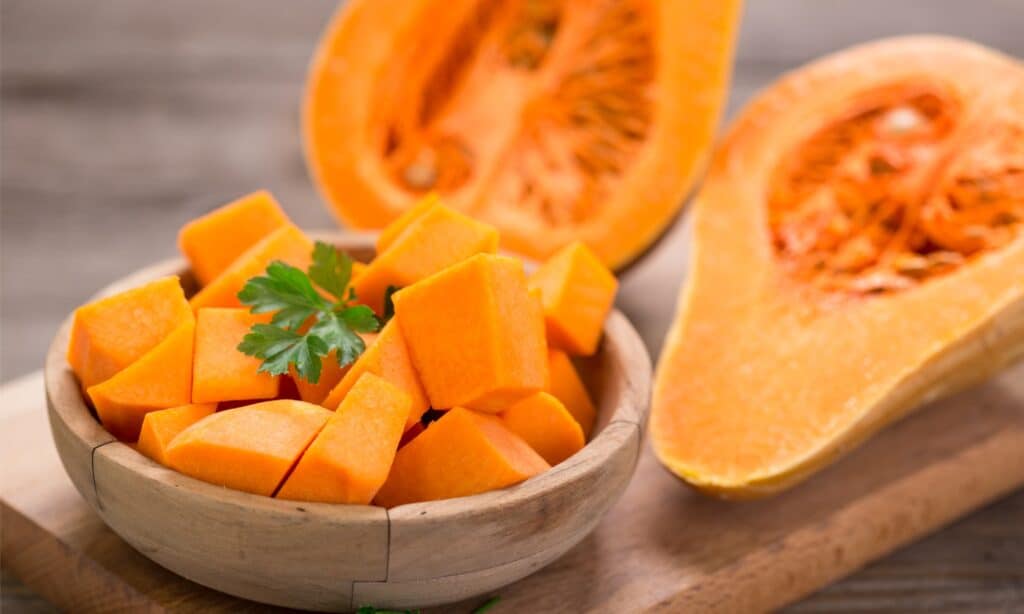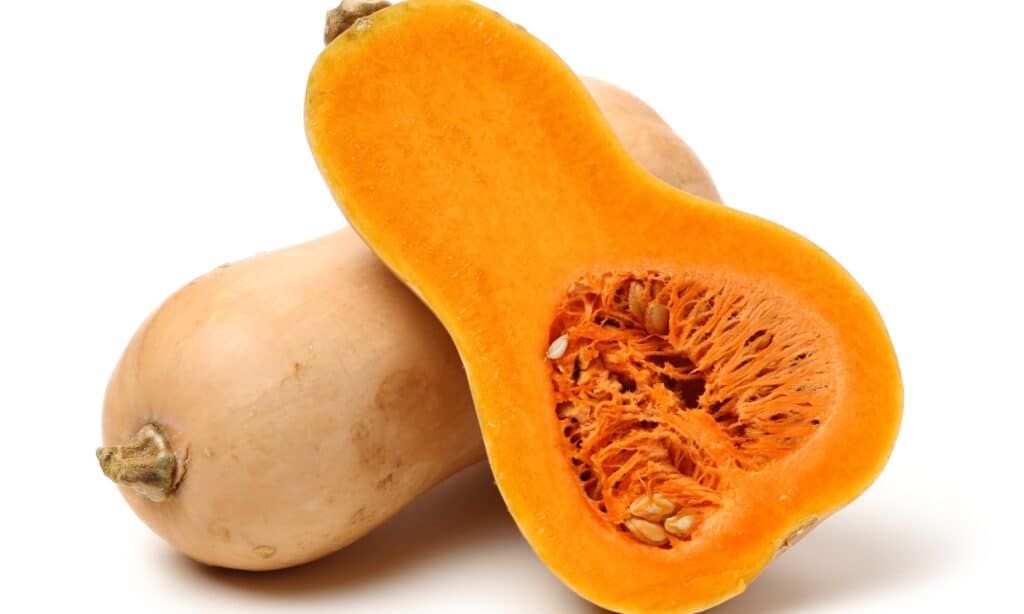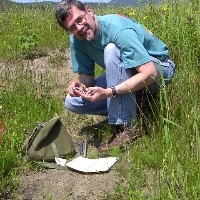↓ Read on to watch this amazing video
Your dog loves you and you want the best for them. Great to see you researching food for your dog. This makes you an amazing dog owner! Can Dogs Eat Butternut Squash? Join us as we answer that question and break down dog diets below!
Can Dogs Eat Butternut Squash?

© iStock.com/pilipphoto
Yes, dogs can eat pumpkin. Butternut squash is a low-cost, nutritious and versatile vegetable that is ideal for pets’ diets.
For all of its nutritional benefits, butternut squash should be a regular part of your dog’s diet. Pumpkin is rich in several vitamins and minerals, and adding it to your dog’s diet can benefit your dog’s vision, immune system, and cardiovascular system.
As with anything you feed your dog, you should understand the risks, benefits, and how to feed your dog. In this article, you’ll learn all about it, and find out how much your dog can get each day. Keep reading to your pup!
Benefits of Butternut Squash for Dogs
Pumpkin has many health benefits for dogs, just as it does for humans. It’s a nutritious food choice for any dog, and 15-25% of a healthy dog’s diet should consist of fruits or vegetables. Beta-carotene and folate are just two of the essential vitamins and minerals found in butternut squash.
The rich phytonutrients in pumpkin also help your dog’s cells function better and make them more efficient. Phytonutrients are very healthy plant-based nutrients. Like antioxidants, they fight free radicals in your pet’s body, reducing the chances of heart disease and other degenerative diseases. Vitamins A, B6, C, potassium, magnesium, calcium, and vitamin B6 are other nutrients found in butternut squash.
Thanks to its high water content (over four-fifths), butternut squash helps add extra moisture. This high-fiber vegetable can reduce colon cancer in dogs and keep their digestive systems in good shape. The actual fiber content helps dogs maintain a healthy weight and regulate their bowel habits.
How Much Can My Dog Eat?
You can give your dog delicious butternut squash every day without risking their health or creating any problems. Unless your dog is allergic to these vegetables, eating butternut squash has no negative effects on dogs.
There is no set amount of butternut squash that dogs can eat, so limit their intake to a few spoonfuls at most. A medium-sized dog can eat one to two tablespoons of butternut squash per day, while large dogs can eat much more.
Toy dogs should only eat one to two teaspoons per day. Or, follow the 10 percent rule and make sure your dog’s pumpkin treats make up more than 10 percent of his daily recommended calorie intake.
Risks of Feeding Pumpkin to Dogs

©iStock.com/chengyuzheng
It can be challenging for dogs to eat and digest raw butternut squash. Dogs should not eat rawhide as it is difficult to swallow and can cause them to choke. Pumpkin can be cooked or pureed to reduce this risk and likelihood. Remove the seeds and pulp, which can cause constipation or intestinal obstruction.
Make sure the squash is always pure, as seasonings in butternut squash soup or other pumpkin recipes may cause severe gastrointestinal reactions in your pet. Butter and other dairy products may upset your dog’s stomach and cause vomiting, diarrhea, and other symptoms. Butternut squash is high in carbohydrates.
Your dog’s body will retain the extra carbohydrates and glucose as fat if it can’t burn them off throughout the day. Avoid exceeding your dog’s calorie allotment and promote regular exercise to prevent rapid weight gain and obesity, which can lead to ongoing joint problems and pancreas inflammation. As long as they are prepared properly and you are feeding in moderation, these risks do not occur.
How to Prepare Butternut Squash for Your Dog
Starting with fresh organic squash is the best way to cook butternut squash for your dog. This helps protect you and your pets from harmful chemical pesticides and herbicides. Microwave the squash for 5 minutes, then poke deep holes in the skin with a fork to make it easier to cut.
Use oven mitts to remove the squash from the microwave and let it cool. Cut the squash in half, scrape out the contents, and discard. You can take the skin off or not. Most of the good-for-you stuff is in the rind of butternut squash. When you cook the squash, the skin becomes soft and tender.
Cut squash into cubes about 1 inch long. Set the oven to 375°F, lightly coat the vegetables with about a tablespoon of virgin coconut oil, and bake for 25 to 30 minutes, or until they are soft enough to cut with a fork. Once the squash is cooked, you can cube it and feed it to your dog as a treat, mix it into their raw kibble, or mash it up for use in homemade dog treat recipes.
in conclusion
While some debate whether dogs are safe to eat pumpkin, the truth is pumpkin is great for dogs to eat in moderation. Pumpkin is a good source of vitamins A and C and fiber. It’s easy and cheap. Before feeding pumpkin to your dog, be sure to scrape up the contents, such as the seeds, as they can be harmful.
It’s important to cook pumpkin before feeding it to your dog to prevent constipation or blockage. Butternut squash is a nutritious treat for dogs. It is rich in vitamins and minerals and is a good source of fiber. You can go all out and make a special treat.
If your dog is picky, you can mix it up and sneak it into their dog food. Your pup will thank you for all the hard work you put into making sure their diet is top-notch. You might even get more couch hugs from it! So give your dogs some pumpkin today; they’ll love it!
Next:
Ready to discover the top 10 cutest dog breeds in the world?
How about the fastest dogs, the biggest dogs, and those who are – quite frankly – just the kindest dogs on earth? Every day, AZ Animals sends out lists like this to our thousands of email subscribers. The best part? free. Join today by entering your email below.

I am broadly interested in how human activities influence the ability of wildlife to persist in the modified environments that we create.
Specifically, my research investigates how the configuration and composition of landscapes influence the movement and population dynamics of forest birds. Both natural and human-derived fragmenting of habitat can influence where birds settle, how they access the resources they need to survive and reproduce, and these factors in turn affect population demographics. Most recently, I have been studying the ability of individuals to move through and utilize forested areas which have been modified through timber harvest as they seek out resources for the breeding and postfledging phases. As well I am working in collaboration with Parks Canada scientists to examine in the influence of high density moose populations on forest bird communities in Gros Morne National Park. Many of my projects are conducted in collaboration or consultation with representatives of industry and government agencies, seeking to improve the management and sustainability of natural resource extraction.











